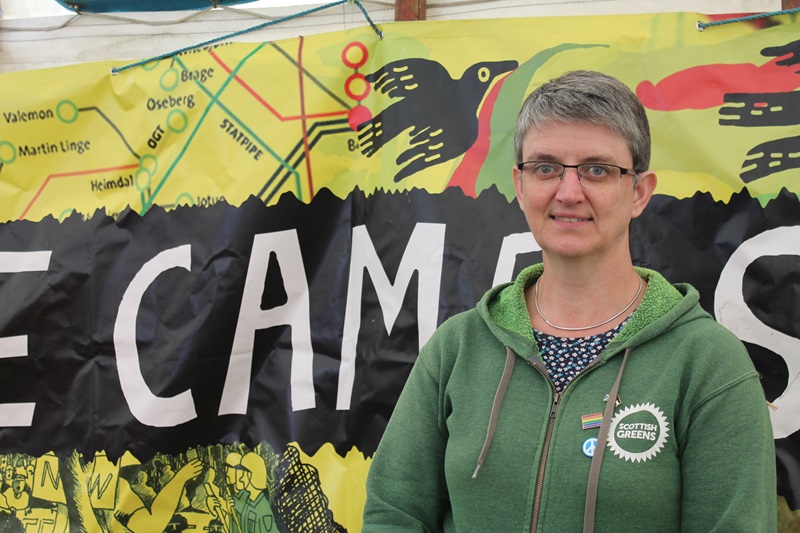The oil and gas industry aims to bring clean jobs to Aberdeen, but it involves paving over part of a much-loved park, igniting a debate on just transition
In the Scottish city of Aberdeen, a debate over the region’s energy transition away from fossil fuels is playing out over roughly one square mile of green space.
In question is a proposed development called the Energy Transition Zone (ETZ), which is intended to bring in more renewable energy investments as the city tries to cut its dependence on the oil and gas industry that has defined it for half a century.
As the UK’s new Labour government promises not to issue any more oil and gas licences, the future of the sector is in doubt and the company behind the ETZ says it wants to “protect and create as many jobs as possible” in the region through investing in clean energy.
But the ETZ has received significant pushback from community groups in the part of Aberdeen it is destined for. That’s because the proposed development, as currently designed, would pave over about a third of St. Fittick’s Park in Torry, the only public green space in one of Scotland’s most neglected urban areas.
The battle over St Fittick’s Park illustrates the friction that is emerging more frequently around the world as the ramp-up of clean energy infrastructure changes communities. Climate Home has reported on these tensions provoked by Mexico’s wind farms, Namibia’s desert hydrogen zone, Indonesia’s nickel mines and Germany’s Tesla gigafactory.
Just transition?
The ETZ is backed by fossil fuel giants BP, Shell and local billionaire Ian Wood, whose Wood Group made its money providing engineering and consulting services to the oil and gas industry.
The plan is to create campuses focused on hydrogen, carbon capture and storage, offshore wind, and skills development in an area initially the size of 50 football pitches, but expanding as private investment grows.
To this end, ETZ Ltd – the company set up to build and run the zone – will receive up to £80m ($103m) from the UK and Scottish governments. Announcing some of that funding in 2021, the Scottish government’s then net zero, energy and transport secretary Michael Matheson said “urgent, collective action is required in order to ensure a just transition to a net-zero economy”, adding “Scotland can show the rest of the world how it’s done”.
But many Scottish climate campaigners don’t see this as a just transition. About 100 of them travelled to St. Fittick’s Park last week to hold a five-day “Climate Camp” in a clearing that would become part of the ETZ.
One camper, who did not want to give her name, told Climate Home that the energy transition should not “exacerbate existing inequalities, but try to redress existing inequalities”. A just transition, she said, must protect both workers in the fossil fuel industry and community green spaces.
Another protestor who did not want to giver her full name is Torry resident Chris. She said “the consultation process was flawed”. Not many people participated to start with, and some stopped going to meetings because “they were disillusioned with the way that good ideas were co-opted and then used to justify the expansion of the industrial area into the park”, she added.

Green MSP Maggie Chapman at the Climate Camp on 13 July (Photo: Hannah Chanatry)
Local Member of the Scottish Parliament (MSP) Maggie Chapman, from the Scottish Green Party, agreed, adding “the best transition zone plan in the world will fail” if it is done to a community rather than with meaningful input from them.
Another protesting resident, David Parks, said wealthier parts of the city would not have been disregarded in the same way. “You wouldn’t see this in Old Aberdeen and Rosemount,” he said. “[Torry] is just kind of the dumping ground for all these projects that you wouldn’t get off with anywhere else.”
Industrial developments have encroached on the old fishing town of Torry for decades. Today, residents are hemmed in by an industrial harbour, roads and a railway and live alongside a waste-to-energy incinerator, a sewage plant, and a covered landfill.

David Parks at the Climate Camp in St. Fittick’s Park on 13 July (Photo: Hannah Chanatry)
Some of the activists also take issue with the emphasis the ETZ places on hydrogen and carbon capture and storage, which they see as “greenwashing”.
Hydrogen is a fuel that can be made without producing greenhouse gas emissions, and used to decarbonise industries like steel-making which are difficult to clean up.
But a Climate Camp spokesperson told Climate Home that, “given the industry’s tendencies” and the fact that 99% of hydrogen is currently made using fossil fuels, they assume it will be produced in a polluting way at the ETZ.
Backers respond
ETZ Ltd told Climate Home in a statement that the project is committed to collaborating with the local community, particularly on efforts to refurbish what would be the remainder of the park.
While the ETZ’s opponents argue there are existing industrial brownfield sites in the area that could be used instead of the park, the company said the area in St. Fittick’s Park next to the port is essential for the development to draw in substantial investment for renewables and for Aberdeen to compete in a new energy market.
Many brownfield sites are already planned for use by the ETZ, and would not provide the kind of logistical access needed for the planned projects, they added.
Sign up to get our weekly newsletter straight to your inbox, plus breaking news, investigations and extra bulletins from key events
“Almost all other ports in Scotland are making similar investments, and we simply don’t want Aberdeen to miss out on the opportunity to position itself as a globally recognised hub for offshore renewables and the significant job benefits this will bring,” said the statement.
The company added that the original plans for use of the park had been considerably reduced and the new master plan includes several measures to revitalise parts of the park and boost public access. It includes several parklets, a boardwalk, enhanced wetlands and a skate and BMX bike park.
While the oil industry’s backing has raised campaigners’ eyebrows, ETZ Ltd said the industry’s involvement is key to ensuring the development of skills and jobs central to the ETZ’s goals.
The section of St. Fittick’s Park up for development was rezoned in 2022 by the Aberdeen City council in order to allow industrial use of the land. Campaigners have challenged that decision and Scotland’s highest civil court will issue a judicial review later this month.
“You can’t just switch it off”
The ETZ dispute is just one example of efforts across Scotland to navigate the planned shift away from fossil fuels to renewable energy.
Tools to support a transitioning workforce have stalled. An offshore skills passport is meant to streamline and unify the certification process for both the fossil fuel and renewable offshore industries, to enable workers to go more easily from one sector to the other. But it was delayed for years before a “roadmap to a prototype” was released in May this year.
“The people can see a future, but it’s not happening – and they can see the current reality, which is [fossil fuels] declining, and that makes it very challenging,” said Paul de Leeuw, director of the Energy Transition Institute at Aberdeen’s Robert Gordon University.&nbs
Read More

